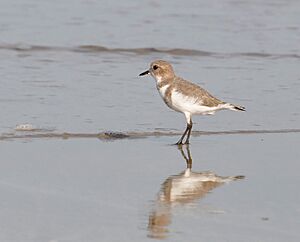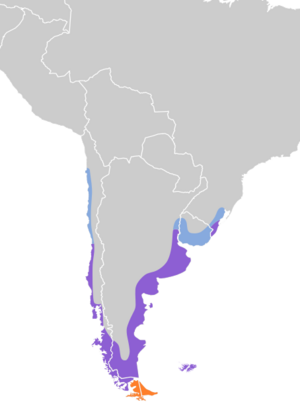Two-banded plover facts for kids
Quick facts for kids Two-banded plover |
|
|---|---|
 |
|
| Non-breeding | |
| Conservation status | |
| Scientific classification | |
| Genus: |
Anarhynchus
|
| Species: |
falklandicus
|
 |
|
| Synonyms | |
|
Charadrius falklandicus (protonym) |
|
The two-banded plover (Anarhynchus falklandicus) is a small bird. It belongs to the plover family. You can find this bird in South America. It lives in countries like Argentina, Brazil, Chile, the Falkland Islands, and Uruguay.
Contents
About the Two-Banded Plover
What's in a Name?
Scientists sometimes thought the two-banded plover was the same as the puna plover. But now, they see them as very close relatives. It's like they are part of a special "super-family" of birds.
How to Spot This Bird
The two-banded plover is about 17 to 19 centimeters (6.7 to 7.5 inches) long. It weighs about 62 to 72 grams (2.2 to 2.5 ounces). It looks a bit "potbellied." Its beak and legs are black.
When breeding, male birds have a white face, chest, and belly. They have a black bar on their forehead. Their head and neck are a reddish-brown color. Their upper body is brown. They have two black bands across their chest. The top band is often broken. This broken band is more common in birds from the Falkland Islands.
Female birds have duller colors. Their black parts are more brownish. Their upper chest band has white spots. When not breeding, both males and females look grayer. Young birds look like non-breeding adults. But their chest bands are brown. Their face is darker, and their upper feathers have buffy edges.
Where Do Two-Banded Plovers Live?
The two-banded plover lives on the Falkland Islands. It also lives along the coasts and a bit inland in Argentina, Uruguay, and parts of Brazil and Chile.
It likes places with gravel shores and sandy beaches. You can also find it in wet grasslands. It often stays near fresh or salty streams and ponds. When it's not breeding, it also visits muddy areas near the ocean. Most of these birds live near the coast. But some breed high up in the mountains of southern Argentina. They can be found as high as 1,200 meters (3,900 feet) above sea level.
How Two-Banded Plovers Behave
Traveling and Moving Around
Some two-banded plovers in Chile and Argentina stay in the same place all year. A small group in Brazil also stays put. But most of these birds migrate. This means they travel north for the winter. They go to southern Uruguay and southeastern Brazil. Almost all the birds from Tierra del Fuego also migrate. The plovers on the Falkland Islands do not migrate; they live there all year.
When it's not breeding season, these birds are quite social. They gather in loose groups. These groups can have up to 200 birds!
What Do They Eat?
The two-banded plover looks for food near the ocean waves. It also searches on mats of seaweed that wash ashore. They find food in short grass and at the edges of freshwater ponds. Their diet is mostly small creatures without backbones. This includes worms, clams, snails, insects, and spiders.
Reproduction and Life Cycle
Two-banded plovers usually lay their eggs from September to January. Sometimes they lay eggs later. Their nest is a small dip in the ground. They sometimes line it with plants. A female plover lays two to four eggs. Both parents help to incubate the eggs. This means they sit on them to keep them warm. We don't know how long it takes for the eggs to hatch. We also don't know how long it takes for the young birds to fly.
What Sounds Do They Make?
The two-banded plover has a special song. It's believed to be their display song. It sounds like "whit-whit-whitrrrrrrt." It's a repeated sound with soft notes followed by a rough trill. They also make short, strong calls. These calls sound like "pit" or a softer "whit."
Is the Two-Banded Plover Safe?
The IUCN (International Union for Conservation of Nature) says the two-banded plover is of "least concern." This means they are not worried about it becoming endangered soon. This bird lives in a very large area. Even though we don't know exactly how many there are, their numbers seem stable. Scientists have not found any immediate threats to this bird.


